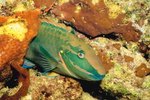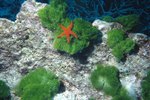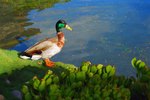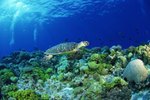Coral reefs are shallow-ocean habitats that are filled with sea life. The massive structure that the coral reef is comprised of is actually built out of coral polyps, which are small marine animals that thrive in colonies. Hard structures are left behind when these marine creatures die, and the stony and branching structure that is left is limestone sturdy enough to create a habitat for new species.
Types

There are both hard corals and soft corals, which fall into three types of coral reefs. Fringing reefs form along coastlines, growing in shallow water along a continental shelf. Barrier reefs grow further out in the ocean, but are still parallel along the shoreline. Coral atolls grow in rings atop long forgotten volcanoes deep in the ocean. They begin their life as fringe reefs, and then continue to grow as the volcano begins to sink until all that remains is the reef itself.
Inhabitants

The physical characteristics of coral reefs allow many marine species to call them home. This truly complex habitat is home to fish, sponges, eels, jellyfish, sea stars, anemones, crustaceans, snails, turtles and mollusks. Mollusks that call coral reefs their home include octopi, nautilus and clams. Crustaceans that call coral reefs their home can include crabs, lobsters and shrimp. Some of the species of fish that live in coral reefs include reef sharks, clown fish, parrot fish, scorpion fish and snappers.
Location

Coral reefs are generally developed in warm, shallow waters along land formations. The marine animals that form coral reefs tend to prefer water that is between 70 and 85 degrees Fahrenheit. The largest coral reef in the world stretches along more than 1,257 miles along the coast of northeast Australia, and it is known as the Great Barrier Reef.
Colonies

Coral polyps can measure between less than an inch and several inches in diameter. One of the largest of all corals is the mushroom coral, Fugia. Mushroom coral is capable of extending as much as 10 inches in its diameter. There are also colonial corals that tend to be much smaller, averaging only 0.04 inch to 0.12 inch in diameter. Colonies of corals can vary in size, from large to small colonies. The Star Coral can colonize to an average height of between 10 feet and 13 feet.
Warnings

Many reefs throughout the world are dying off. There are a number of major threats to the health of coral reefs, including pollution in the water, dredging along the coast, the careless tourist collecting coral and the process of sedimentation from mining and construction projects. Artificial reefs are being created in an attempt to restore these ecosystems, but many coral reefs are still in danger.
References
Photo Credits
-
Comstock Images/Comstock/Getty Images




